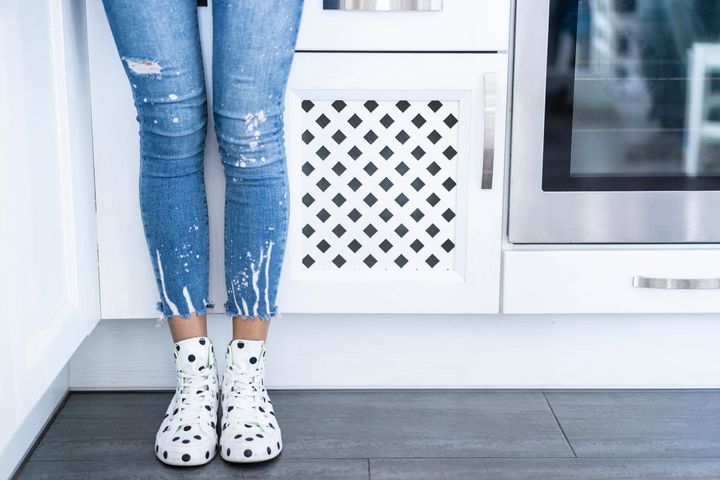When you walk in the door and kick off your shoes, does it actually hurt the health of your feet to walk around barefoot on hard floors? It’s not the most comfortable feeling, but doctors say there can be some benefits — with a few caveats.
First, let’s start with a definition of barefoot: According to the Cambridge Dictionary — and experts ranging from podiatrists to dermatologists — walking barefoot means having no shoes or socks on.
“Barefoot is skin to ground,” explained licensed clinical podiatrist Dr. Robert Conenello. “Anything else is considered to be shod, as even socks alter the mechanics of movement.”
There are benefits to going barefoot at home.
“I’m a big advocate for going barefoot at home,” Conenello said. “[The practice] increases intrinsic muscular strength within the feet.”
He explained that the primary benefit of walking barefoot is the reinforcement of the muscles in the feet, which tend to weaken “as we age and wear shoes.” These muscles are closely linked to our overall mobility, so their deterioration can contribute to reduced movement as we get older.
“Many of the pathologies that I see in my practice are due to the inability to engage these muscles for normal movements and metabolic efficiency,” Conenello added.
Dermatologist Dr. Hannah Kopelman agreed with that overall assessment, and also mentioned that going barefoot at home can have some unexpected benefits for the skin on your feet.
“Walking barefoot at home … allows your skin to breathe, which can help prevent moisture buildup and reduce the risk of fungal infections like athlete’s foot,” she explained.
Although not directly related to dermatology, walking barefoot at home can also offer a secondary skin-related advantage, one connected to sensory stimulation and overall wellness.
“Feeling the texture of different surfaces underfoot can be grounding and relaxing, almost like a mini reflexology session,” Kopelman said. “For those without underlying skin or foot conditions, this can be a natural way to connect with your environment and promote mindfulness.”
To put it concisely, opting to go shoeless and sockless in your clean home helps fortify your feet, providing long-term rewards while also reducing the risk of skin conditions. Additionally, it offers a kind of natural massage, which can be surprisingly relaxing.
But there are some potential downsides.
One potential downside of walking barefoot indoors is the increased exposure to irritants or allergens on the floor, such as dust, pet dander or cleaning chemicals, as Kopelman pointed out. For individuals with sensitive skin or chronic conditions like contact dermatitis or eczema, this could be a significant concern.
While Conenello acknowledges similar risks — such as stepping on pathogens like fungi in moist environments — he is quick to emphasize that “proper hygiene can help mitigate these risks.”
“Wash your feet frequently, dry them thoroughly and moisturize,” he advised.
Other painful risks associated with going barefoot include the potential for slipping on slick or wet surfaces, or stepping on something hard and sharp that could cause injury. As anyone who has ever stubbed a toe or accidentally stepped on a Lego can attest, such incidents can be excruciating. Kopelman points out that individuals with diabetes or poor circulation are more vulnerable to severe consequences, as “even a minor foot injury can lead to serious health issues.”

Vladimir Vladimirov via Getty Images
Kopelman also noted that, while walking barefoot can help strengthen muscles, the repeated practice of doing so on hard surfaces could potentially lead to foot fatigue or plantar fasciitis, a condition where the tissue connecting the heel bone to the toes becomes inflamed.
“Over time, the lack of cushioning can put stress on the joints, especially in those who already have foot or joint issues,” she explained.
There are times when you should wear shoes or socks.
Though Conenello is generally a proponent of going barefoot, he advises wearing foot support when engaging in tasks that involve standing for extended periods of time — like when cooking.
“When standing for long periods barefoot, there can be excessive load to one area of the foot,” he said. “Even my professional cooks usually benefit from a shoe that allows them to balance weight over their entire foot.”
To illustrate the concept further, he made an analogy. “[Let’s say] that you developed some decent core strength through performing some planks,” he said. “I would not suggest you start adding significant time or weight to your exercise routine prematurely.”
There is, of course, a middle ground: socks.
According to Conenello, “there is nothing wrong with wearing socks.” They’ll simply decrease the benefits associated with being barefoot. “There is now a filter between the ground and the foot,” he said.
Kopelman added that socks can offer “minimal protection from minor abrasions or allergens while still allowing your feet to feel relatively free.” Direct contact with surfaces that may harbor bacteria or irritants is also minimized when wearing socks.
Taking all the pros and cons into account, walking barefoot at home — especially on clean and well-maintained floors — is not only safe, but generally healthy … unless you’re dealing with some sort of skin condition (think psoriasis, eczema or athlete’s foot, for example) that could be exacerbated by the presence of bacteria.
“Likewise, individuals with diabetes, neuropathy or poor circulation should avoid barefoot walking due to the increased risk of unnoticed injuries or infections,” Kopelman said.
We Need Your Support
Support HuffPost
Already contributed? Log in to hide these messages.
Going barefoot selectively seems to be the best option. Moderation is, indeed, key.

